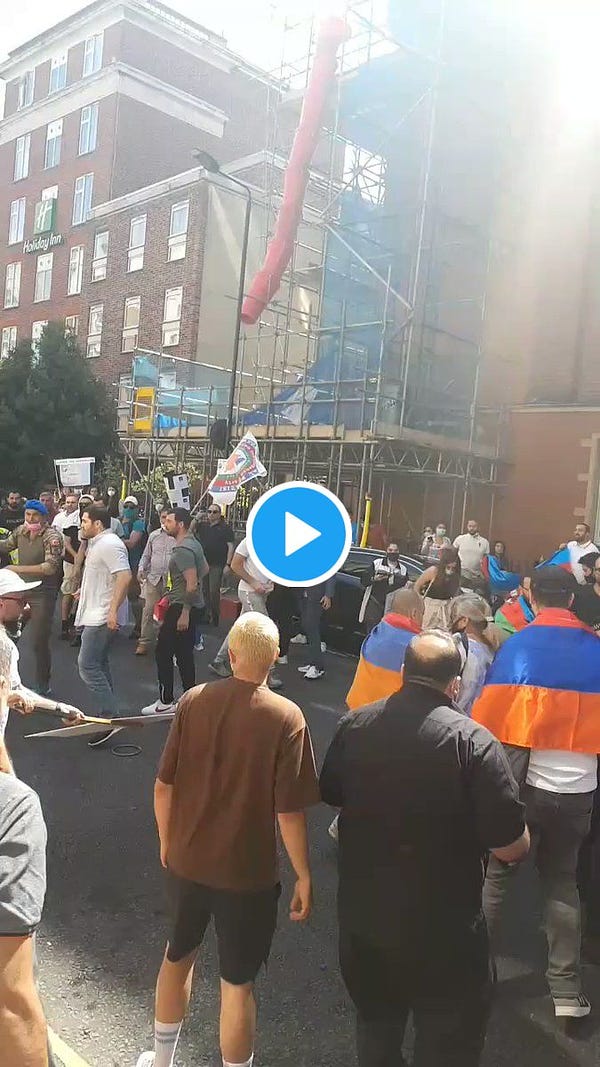Tribalism, Nationalism and War: Hot Afternoons in Armenia's Frozen Zone
The genocidal bloodletting was exactly what America’s cynical imperial planners had long wanted and actively pushed for: the partitioning of the Soviet Union along purely ethno-nationalist lines.
With Armenia and Azerbaijan actively shelling each other again (and Azerbaijan threatening to hit Armenia’s nuclear power plant) over Nagorno-Karabakh, a contested region in the mountains close to their borders with Iran, I figured I’d repost a dispatch I filed from there 14 years ago. This was back when I just was starting out as a journalist — and was working at The eXile.
The dispatch gives an Armenian perspective on the conflict — a conflict that’s part of the many nationalist counter-revolutions and purges and civil wars that popped off across the Soviet Union as old Communist Party power structures crumbled in the late 1980s.
Armenia’s nationalistic communist elite pushed hard for a national reunification with Nagorno-Karabakh. They saw the Azeris who lived there as invaders and agents of the Turks, part of an aggressive empire that has genocided their people and stolen their best land. People who they had lived with in peace in the Soviet Union were now their enemy.
Ultimately this reorganization resulted in a violent ethnic war — a mixture of pogroms, rapes, lynchings, expulsions, traditional military battles, and territorial grabs. In six years of fighting, tens of thousands were killed and more than a million were cleansed from both Armenia and Azerbaijan, according to Thomas de Waal, who wrote perhaps the only good book on the subject: Black Garden.
Gary Kasparov, the chess-savant-turned-liberal-Putin-foe, was from a Jewish Armenian family that lived in Azerbaijan. He was in Baku when the anti-Armenian pogroms broke out. Apparently he made it in out in one piece only because of his supporters back in Moscow, who chartered a small plane to get him and his family out of there: “I will never forget that day. Unimaginable horror overwhelmed Baku. Bandits knew exactly where Armenians lived. People were robbed and killed. Men, women and children were beaten to death in their yards, young girls were raped and burnt alive.”
It was brutal.
In a big way, this two-way genocidal bloodletting was exactly what America’s cynical imperial planners had long wanted and actively pushed for: the partitioning of the Soviet Union along purely ethno-nationalist lines.
Since the end of WWII, the American plan had been to Make Adolf Great Again. And that’s exactly what happened in this part of the world when Soviet power disintegrated. In an ideological vacuum, internationalism and communism were replaced with primal tribalism and rabid nationalism. There were no other ideas. The old beast had returned.
Hell, when I was down there, an Armenian journalist openly praised National Socialism to me — explaining that it was an ideology that was good for the “common good.” And this fight for purity and soil is still going on today — even in diaspora communities.
My dispatch on this is from 2006. But as I understand it, little has changed since.
—Yasha Levine
Hot Afternoons in Armenia's Frozen Zone
By Yasha Levine • August 25, 2006
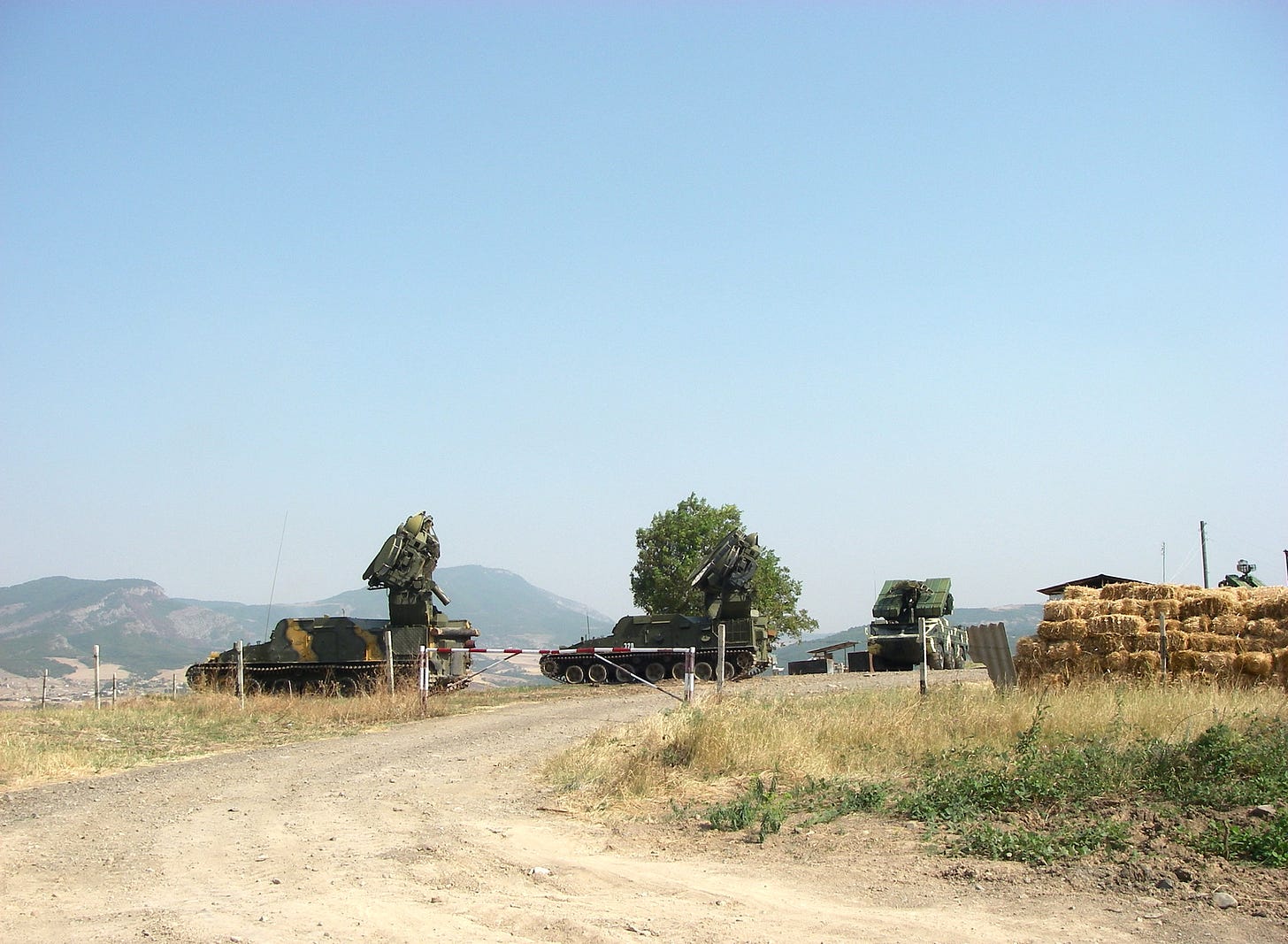
STEPANAKERT, NAGORNO-KARABAKH — It took my taxi driver and me an hour to get out of Yerevan. Most of it was spent waiting in line to fill up his gas tank. Not with gasoline. No, it was the kind of fuel you’d pump into your gas powered BBQ. Ruslan, like most other Armenians living off gypsy cabbing, didn’t have a drop of petrol in his tank when I first got into his Volga. He’d modified it to run on natural gas stored in a large canister in the trunk of his car.
It wasn’t as if Ruslan was some tree-hugging, Prius-seeking hippie-of-the-Caucasus. It was all economics: and the way things work in Armenia today, if they work at all, is that gasoline is way too expensive to be profitable. If he were to use petrol, he’d have to hike his taxi prices so high that he’d be out of business.
Gasoline costs the same in Armenia as in, say, the United States, even though the Caspian oil reserves, among the world’s largest, are right off the coast of Baku just a few hundred miles away. Yet Armenia gets no benefit from that oil at all. In fact it’s one of the poorest countries in the northern hemisphere. Azerbaijan imposed a total economic blockade on Armenia ever since the two fought a bitter civil war over the breakaway Nagorno-Karabakh region between 1988 and 1994. Nagorno-Karabakh was an ethnic-Armenian region within Azerbaijan that for years now has been essentially independent and run by the separatist Armenians.
So at $4 per gallon, it would have cost Ruslan at least $75 in normal automobile gasoline — his month’s salary — to drive me the 300 uphill miles from Yerevan, the capital of Armenia, to Stepanakert, the capital of Nagorno-Karabakh. The same trip cost him about $12 on natural gas.
If internal combustion engines couldn’t be modified to run on natural gas, Armenia wouldn’t have much use for the western standard roads built with millions of dollars that the Armenian Diaspora, many of whom live in the US and Russia, shells out every year. Without that money, Armenians would be back to riding beasts of burden. These days, only the Iranian cargo truckers and the Armenian military get to use real gasoline. All other cars, buses and trucks run on natural gas.
In fact, natural gas not only powers the cars, but also the power plants. And Russia is Armenia’s sole supplier of natural gas, sold at a steep discount to world prices. Without the cheap Russian gas piped in via neighboring Georgia, Armenia would collapse. That means, of course, complete dependence on Russia.
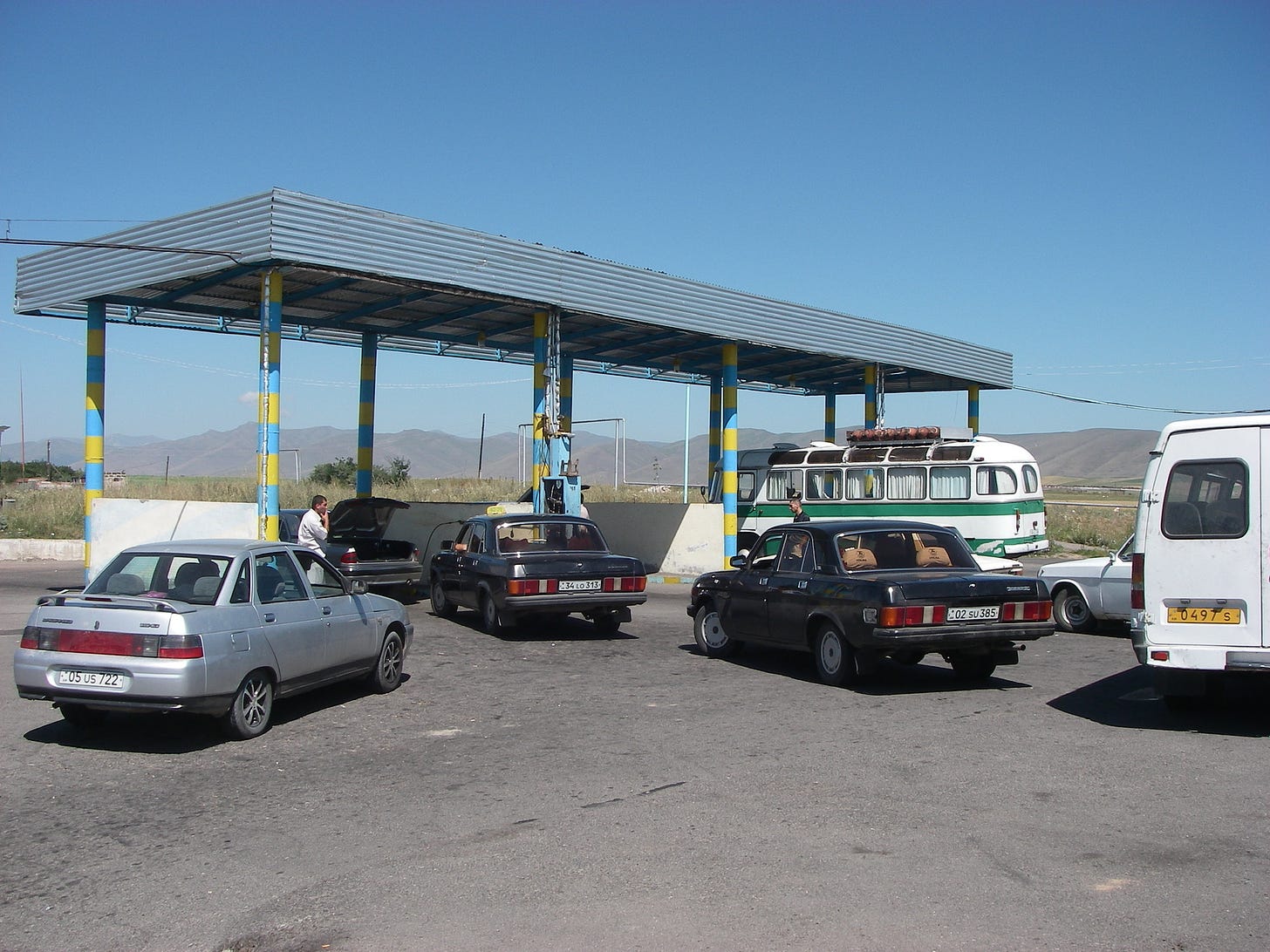
Filling up
There’s another minor downside to Armenia’s natural gas dependency. The containers used to house the liquefied gas have a tendency to turn into high-powered shrapnel bombs if over pressurized or overused. Every once in a while, they blow up and shred everything within a 500ft radius.
“Don’t worry. I have a good canister made in Italy. It doesn’t burst, it just rips,” Ruslan told me. He noticed me looking at eight corroded and scarred canisters stacked under the belly of a 70’s Soviet truck about two feet away from my face. “But those, on the other hand, are old and very dangerous. If one of those canisters blows up, all of them will.”
It’s a good thing that the truck was waiting to fill up. It was pushing 105 degrees out and the canisters were exposed to direct sunlight.
I hired Ruslan to drive me to the decade-old Republic of Nagorno-Karabakh, the tiny Yosemite-sized chunk of land that sparked an all out ethnic turf war between Azeris and Armenians and made Armenians the victorious underdogs heroes of every Caucasian separatist movement.
In 1994 the Armenians won and forced Azerbaijan to a ceasefire. In the meantime Nagorno-Karabakh organized itself into a sovereign country with its own army, elected officials and parliament. But it still hasn’t been recognized by any country other than Armenia and is still classified as one of the “frozen conflicts” in the region, along with the breakaway regions of Abkhazia and South Ossetia in Georgia.
But this “frozen conflict” may soon heat up, if you believe what Azerbaijan’s playboy/gambling addict/president, Ilham Aliyev, says. Not that Azerbaijanis should get too excited about another war: If Armenians are still the fighters they were ten years ago, then statistically, it’s the Azeris who’ll do most of the dying. While matched evenly in soldiers, the Azeris had double the amount of heavy artillery, armored vehicles, and tanks than the Armenians; but when it was over, the Azeri body count was three times higher then that of the Armenians. Azeri casualties stood at 17,000. The Armenians only lost 6,000. And that’s not even counting the remaining Azeri civilians the Armenians ethnically cleansed.
Since the strategically-important Baku-Ceyhan oil pipeline opened up, pumping Caspian Sea oil to the West via Turkey, the Azeri president has been making open threats about reclaiming Nagorno-Karabakh by force. The $10 billion in oil revenues he expects to earn per year once the pipeline is fully operational is going to his head. $10 billion might not seem that much — but for Azerbaijan it constitutes a 30% spike in GDP. In every single interview, Aliyev can’t even mention the pipeline project without veering onto the subject of “resolving” the Nagorno-Karabakh conflict.
Aliyev started spending the oil cash even before the oil started flowing and announced an immediate doubling of military spending. A little later he announced the doubling of all military salaries. Aliyev’s generals aren’t squeamish about bragging that by next year their military budget will be $1.2 billion, or about Armenia’s entire federal budget.
The Western press seems to think he’s bluffing to shore up domestic political support. But Azeris consider Nagorno-Karabakh their historic homeland and don’t consider the 10-year ceasefire as a final defeat. Azerbaijan has been keeping their Karabakh refugees in tents and boxcars to prove it. And if Georgia takes military action against Abkhazia and South Ossetia, Azeris may do the same.
There is a Bush Administration/War On Terror factor here that I won’t get into, and it is this: America has been a strong supporter, militarily and otherwise, of both Georgia and Azerbaijan, which has given both countries more confidence to solve their problems with armed force. Moreover, a big part of the neocon plan to attack Iran involves stirring up that axis of evil’s sizeable Azeri minority.
I went Armenia and Nagorno-Karabakh to find what the Armenians, who seemed so lost and doomed in all of this, are saying — and the kind of trenches they were digging.
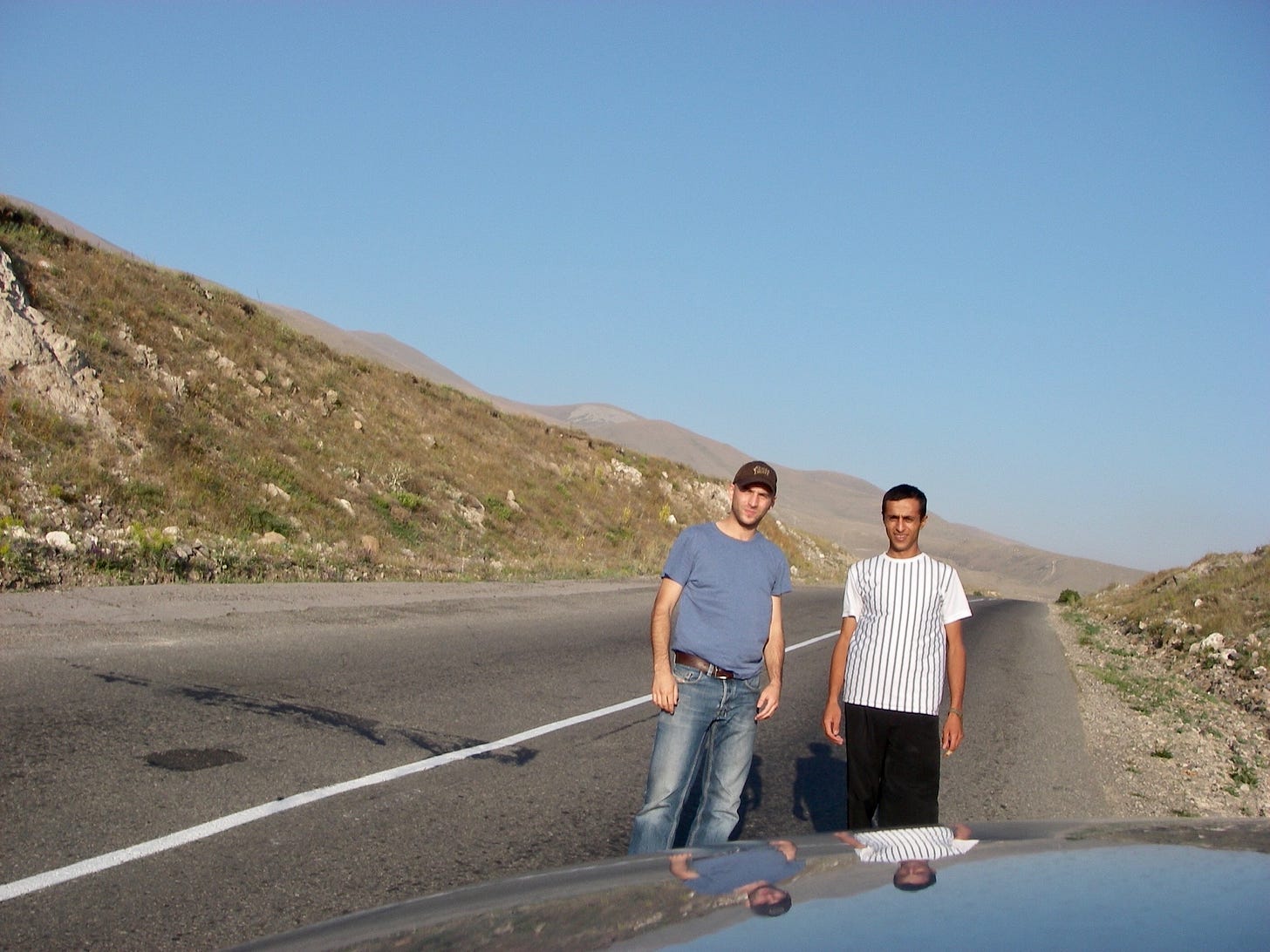
On the road
“Did you know that Azerbaijan is doubling its military budget and threatening to take back Karabakh by force?” I asked Ruslan.
He just shrugged his shoulders.
“So what if they spend more money on their military than we do, it doesn’t mean anything. Let them spend ten times more, it won’t matter. The Turks don’t have a mind for machinery. They don’t know how to operate it and when they break it, they don’t know how to fix it. They’re horrible mechanics and engineers. Right now, all of their machinery is rusting out,” he said coolly.
“So you call Azeris Turks?” I asked.
He smiled. “No, not Turks. Defective Turks.”
Ruslan was a scrawny 23-year-old bakinets, an ethnic Armenian from Azerbaijan’s capital, Baku. He fled the city with his mother after a roving mob of Azeris tore his father to bits with their bare hands. That was in 1988, just when the Azeri pogroms against the Armenians were igniting in Sumgait and Baku. Ruslan and his mom got out through Georgia and bounced around Abkhazia and Ukraine before settling in a kamunalka apartment filled with Armenian refugees in Yerevan. The rest of his family settled in a village 30 miles from Yerevan.
Ruslan went to school and was drafted into the Armenian army at 18, and served in Nagorno-Karabakh.
The Republic of Nagorno-Karabakh has its own constitution, president, parliament and army, but it’s a sovereign country only on paper. Without Armenians from Armenia-proper like Ruslan willing to pay and die for the cause, Karabakh would never hold its own against the Azeris next door.
“So, do you think the Turks are going to try to take Karabakh back? Do they have a chance?” I asked.
“I don’t know,” Ruslan replied. The “cool road mix” CD that his friend handed off to him looked like it had been ground against asphalt and was skipping on every track, but he was intent on getting Shakira back on. Even when we went out drinking in Yerevan the night before, I had to drag his army stories out of him. He seemed bored as he told the story of how his army pal shot down a female Azeri sniper from a tree with a few blasts from his AK.
“If they were to attack, would you fight for it?” I asked.
“I don’t know,” he repeated. “But if they do, I can tell you that we’re not going to stop at our borders of Karabakh, like we did last time. If they attack, this time, we’re marching to go all the way to Baku.”
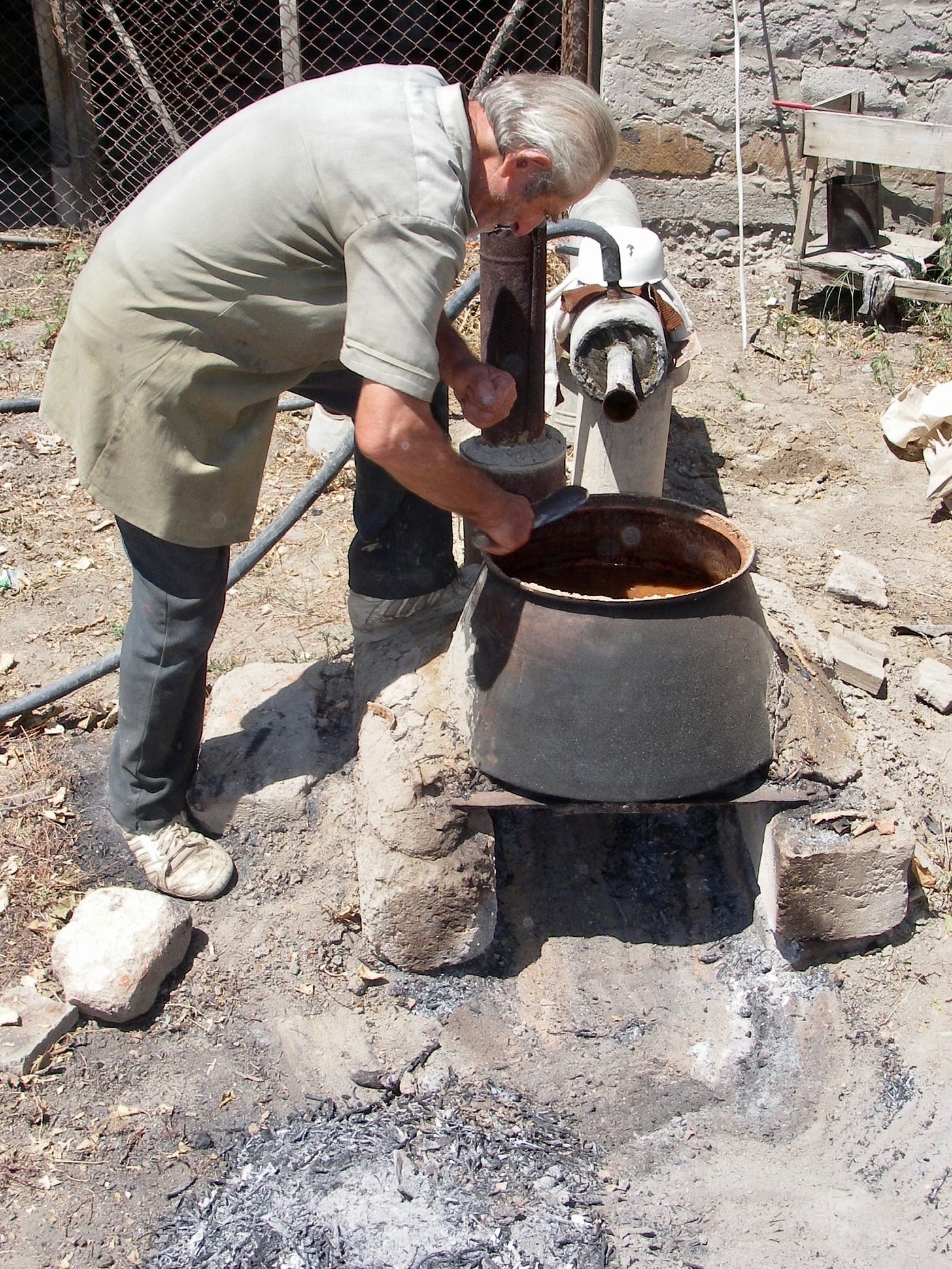
Making peach samogon.
We took a detour to stop by Ruslan’s family’s village about an hour outside of Yerevan. They were also bakintsi and were smart enough to trade in their standalone house in Baku when they fled for a few acres of farmland and a couple mud brick shacks in what used to be an exclusively Azeri village within Armenia. After they arrived, Ruslan’s uncle went off to fight in Karabakh and never came back.
Ruslan’s grandmother gave me a skewed look when I asker her if any Azerbaijanis still lived in the village. “No, there are no more Turks living here. Everyone in the village are Armenians from Baku,” she said. 600,000 Azeris from all over Armenia and Karabakh were booted or fled from Armenia following the Karabakh war. In return, 250,000 Armenians were sent packing back to their historic homeland.
In Azerbaijan, Ruslan’s family was made up carpenters, plumbers and housewives. But in Armenia they went native and took up farming. Just like Ruslan’s natural gas option, it wasn’t by choice.
While Ruslan’s grandmother laid the table, his grandfather showed me his samogon gear. He just began distilling a new batch from homegrown peaches.
“If you lived in the city, how did you learn to farm,” I asked him.
“We had to, so we learned.”
Ruslan’s grandmother set the table exclusively with homegrown produce. The bread, the apricot jam, the fresh pears, the kefir, the cheese, the eggplant spread and the vodka were all domashnye. They still raised chickens and when the grandfather had more energy, he used to have a few cows.
“Ah! Who needs that Karabakh,” is all I got out of gramps on the subject. He lost his son there and so preferred to explain his samagon distillation techniques.
Gramps was a broken man. He’d never been to Karabakh and didn’t plan on going. In fact most mainland Armenians had never visited the place. Why waste the fuel? What’s there to see? Why did they even fight for it?
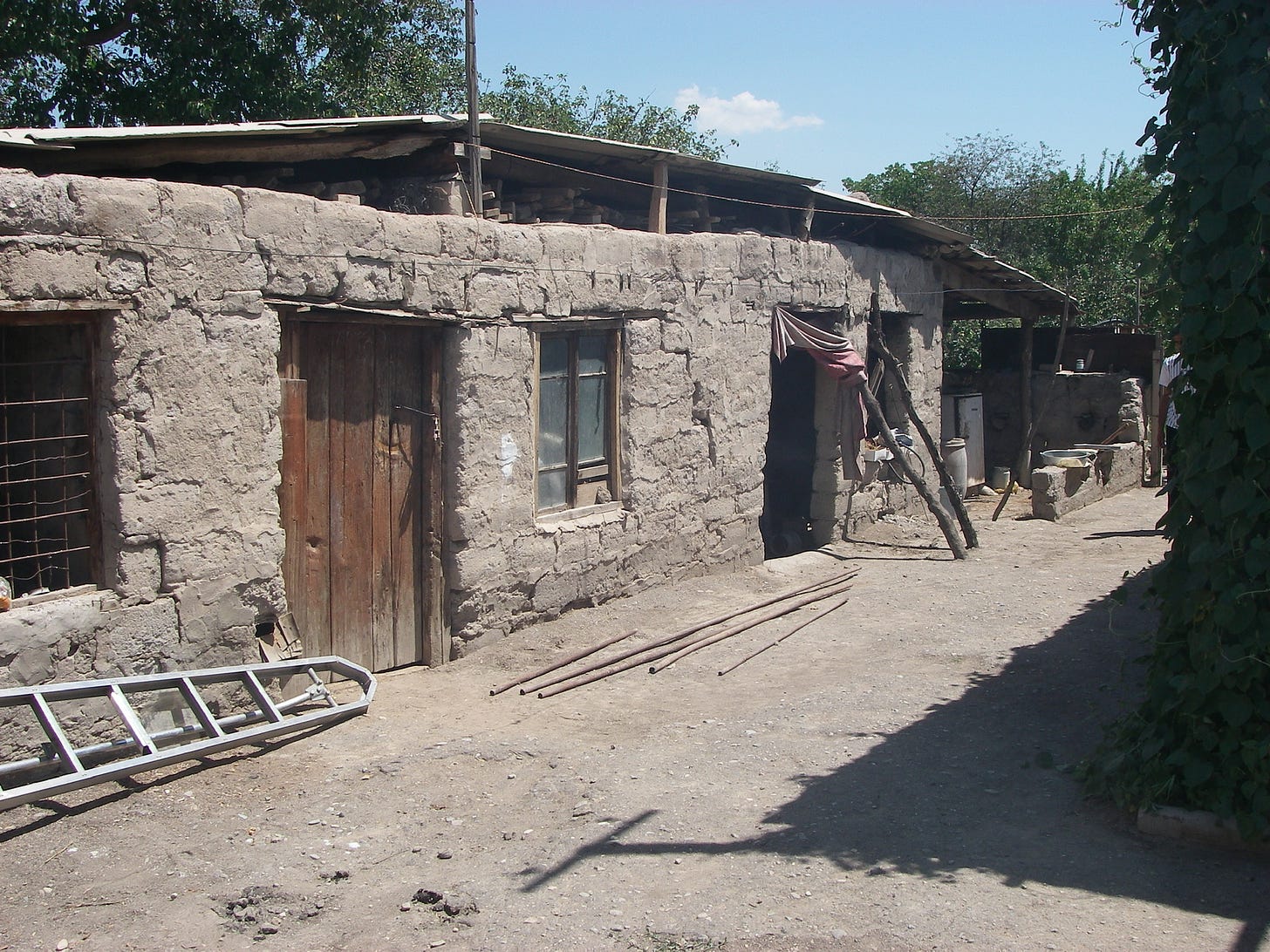
Ruslan’s grandparents’ house
But that evening, after we were waved passed the Karabakh’s border control without having our documents checked, I finally saw why Nagorno-Karabakh was worth fighting for. The place is like a condensed version of the best scenery of Northern California and the Sierra Nevadas put together: 6,000 ft mountains, rolling golden-sunburned pastures, sandstone hills, steep limestone cliffs, and mountain streams. It’s easily the most beautiful region in Armenia. Even the women were better looking there than in Armenia proper: thinner, taller, and shapelier.
Ruslan promptly introduced me to two of his army buddies, Vadim and Veretan. Vadim rolled up to my hotel in his father’s 80’s 3 series BMW. He was clearly privileged: his father used to be the KGB director for one of Karabakh’s districts and as a result Vadim had a cushy job working as an ambulance driver. Veretan worked as a technician at Karabakh’s only TV station that broadcast its signal a few hours each day.
After I picked up the $45 tab for the four of us at the most expensive restaurant in Stepanakert, Vadim and Veretan agreed to show me around their country — provided that I pick foot the bill for the pricey petrol.
As we were climbing up to the Shushi, a town perched right above Stepanakert, Karabakh’s capital, Vadim said, “You could fire whatever you want from there and it will hit Stepanakert. Mortars, RPGs, Kalashnikovs, anything.”
Shushi used to be Karabakh’s Azeri capital and the region’s second-largest town before the Karabakh war broke out. Although the Azeris had a military and strategic advantage, located up above the Armenian-controlled Stepanakert in Shushi’s insurmountable old fortress and prison, they made a fatal strategic mistake. The Azeris should have shelled Stepanakert into a heap of rubble before the Armenian resistance had a chance to build up its arms and attack. But the Azeris were so overconfident that they didn’t want to destroy a city that they were sure would soon be theirs.
The Armenians weren’t as soft, people bragged. Under artillery cover, they launched a surprise attack by climbing a 90 degree slope to storm Shushi in 1992 by foot. It was the same slope from which Armenian girls jumped to their deaths to avoid being raped by Azeris. With that kind of motivation, the Armenians had no qualms about turning Shushi into a mini Sarajevo.
A
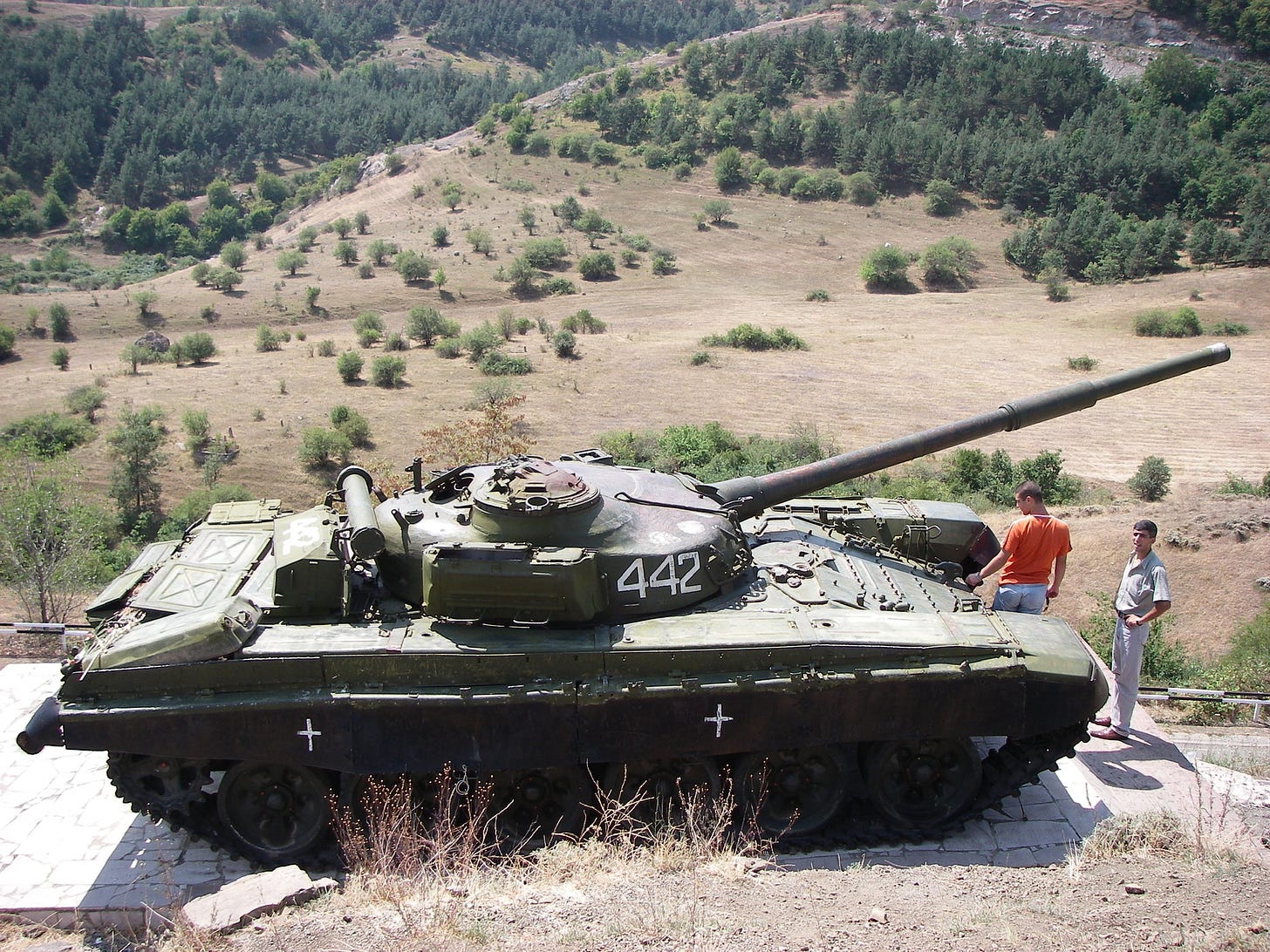
A monument to Armenian victory
All the Azeris are gone now. And the few Armenians that remain live in squalor, even by Karabakh’s standards. There is no foot traffic, no car traffic and no stores — just a kiosk selling icons and a western-style hotel catering the Armenian Diaspora. A renovated church in which a few grossly overweight Americans snapped photos, a burned out early 20th century Soviet building, a prison, and two gutted mosques with minarets were all this town had to offer.
“When Armenians liberated Shushi this church was filled to the top ceiling with boxes of munitions. Fucking Turks. They have no respect for anything but their Islam.” Vadim said. Veretan nodded in approval.
The apartment buildings that weren’t leveled were looted and picked clean of windows, pipes, sinks, toilets and anything else remotely valuable. The few functioning buildings are a disaster waiting to happen — a checkerboard of lopsided balconies, windowless rubble, rust, and peeling paint.
“It’s a good business. You buy an empty apartment for about $4,000 and sit on it. Slowly, water is being hooked up to them again and they are being restored. In a few years, you can make a good profit.”
Not bad. Most of the apartment buildings were gutted out and ready for unlimited personalized remont possibilities. And what’s more, all of them had aerial views into the valley bellow. But the four grand was way out of these peoples’ league. By official statistics from the office of the Republic of Nagorno-Karabakh, the country’s average monthly salary was $50, but that’s for those lucky enough to find jobs. Shushi’s residents can’t even afford gas for heating and cooking. Every balcony had a store of firewood that was sure enough to last the winter.
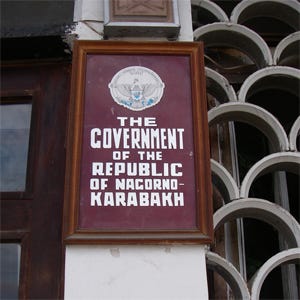
Welcome to the Government
Stepanakert, wasn’t as depressing as the other half-abandoned towns and villages. It was the capital, after all, and the symbol of Armenian victory: the Armenian Diaspora wasn’t going to just let it decay. Despite the fact that Stepanakert has no industries to speak of, the city of 40,000 Armenians had all the trappings of a developing provincial capital.
Except for a few shrapnel-scarred buildings, you wouldn’t even guess that the city had once come under heavy shelling. There were hundreds of small fruit stands, restaurants, dozens of Internet cafes and taxis circling the city center. A couple of Western-style hotels built by and catering to the Armenian Diaspora popped up in the past few years, and a luxury apartment complex was being built right across from the government building.
“About 20% of the population lives in chocolate, the rest live in total shit. That 20% contains all the friends and relatives of government or army officials,” Vadim said, pointing to the luxury building.
The Nagorno-Karabakh Defense Army has about 20,000 active military personnel. But taking into account the region’s tiny population of 140,000, Karabakh tops even Israel and North Korea as among the most militarized countries in the world per capita. 1 out 7 people is actively serving in Karabakh’s army. North Korea, by comparison, has a ratio of only 1 out of 20.
Although you have to go outside the city side to see the surface-to-air missile batteries that dot the country, Stepanakert’s streets are teeming with men decked out in green camo uniforms, leisurely rolling around on their green UAZ army jeeps.
“You know, people in Karabakh say this joke when a baby is born. They say, ‘Is that a girl or a lieutenant?'” Ruslan explained to me on our drive into Stepanakert.
Vadim put it another way. “There’s not much else to do in Karabakh. There are no jobs and the army pays well… You have a choice, you can either farm or serve.”
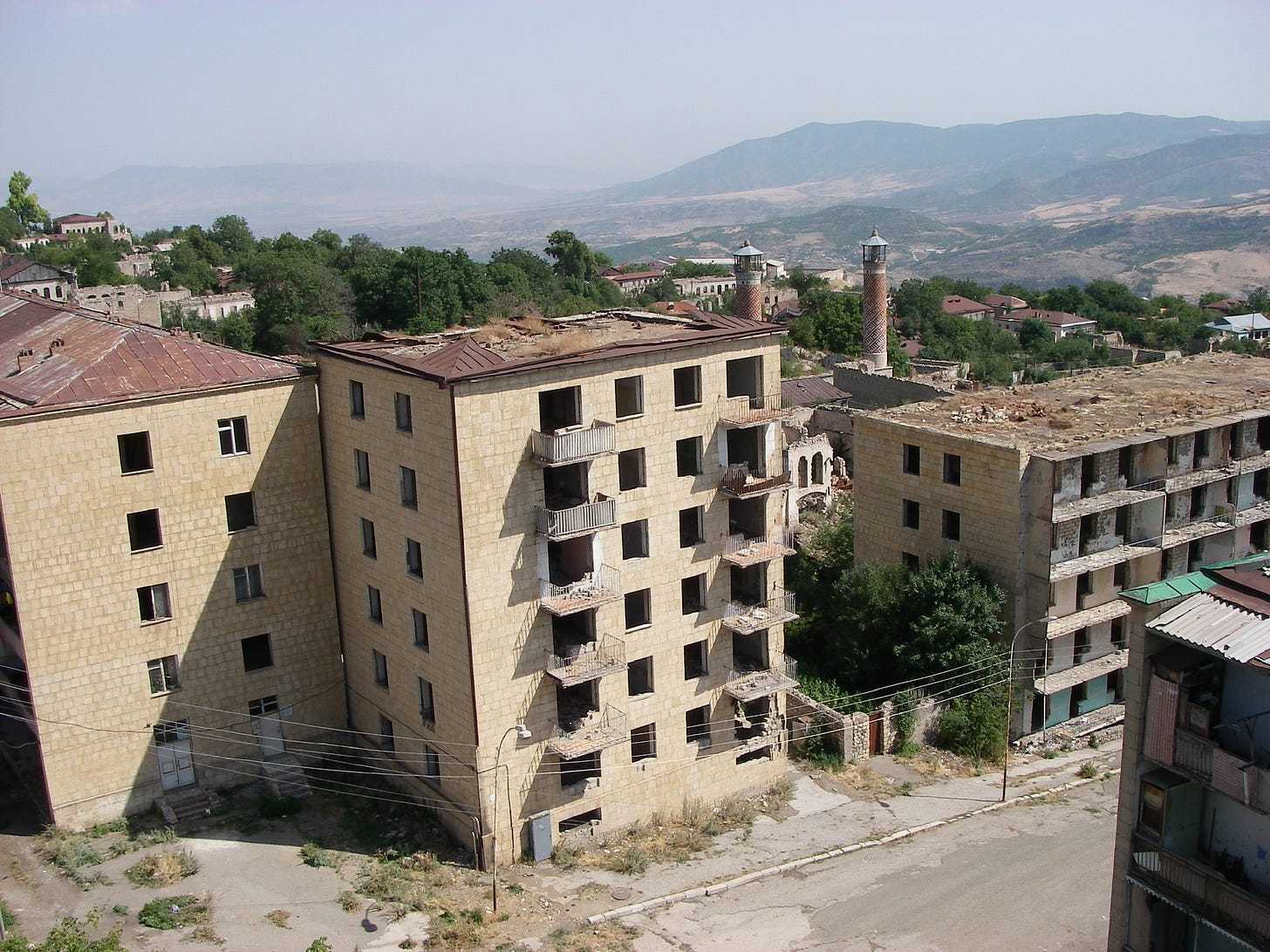
Bombed out mosque and rotting apartment blocks in Shushi
“People here are building castles, but we should be building underground! Cities, bomb shelters, schools… To wage war, you don’t need to invade with troops. It’s enough to send missiles. We need to build underground so that when they level our cities, we’ll survive and be able to fight,” Murad Petrosyan, the founder of an independent Karabakh monthly newspaper called What is to be Done and a host on a Karabakh TV political talk show , told me.
We met in the patio of my western-style hotel in Stepanakert built by an Australian-Armenian. It was noon and already pushing 105 degrees.
This is a preview of a full letter that is only available to subscribers. To get the rest, sign up and read it here.
Subscribe to Immigrants as a Weapon and get access to member-only notes and letters.




